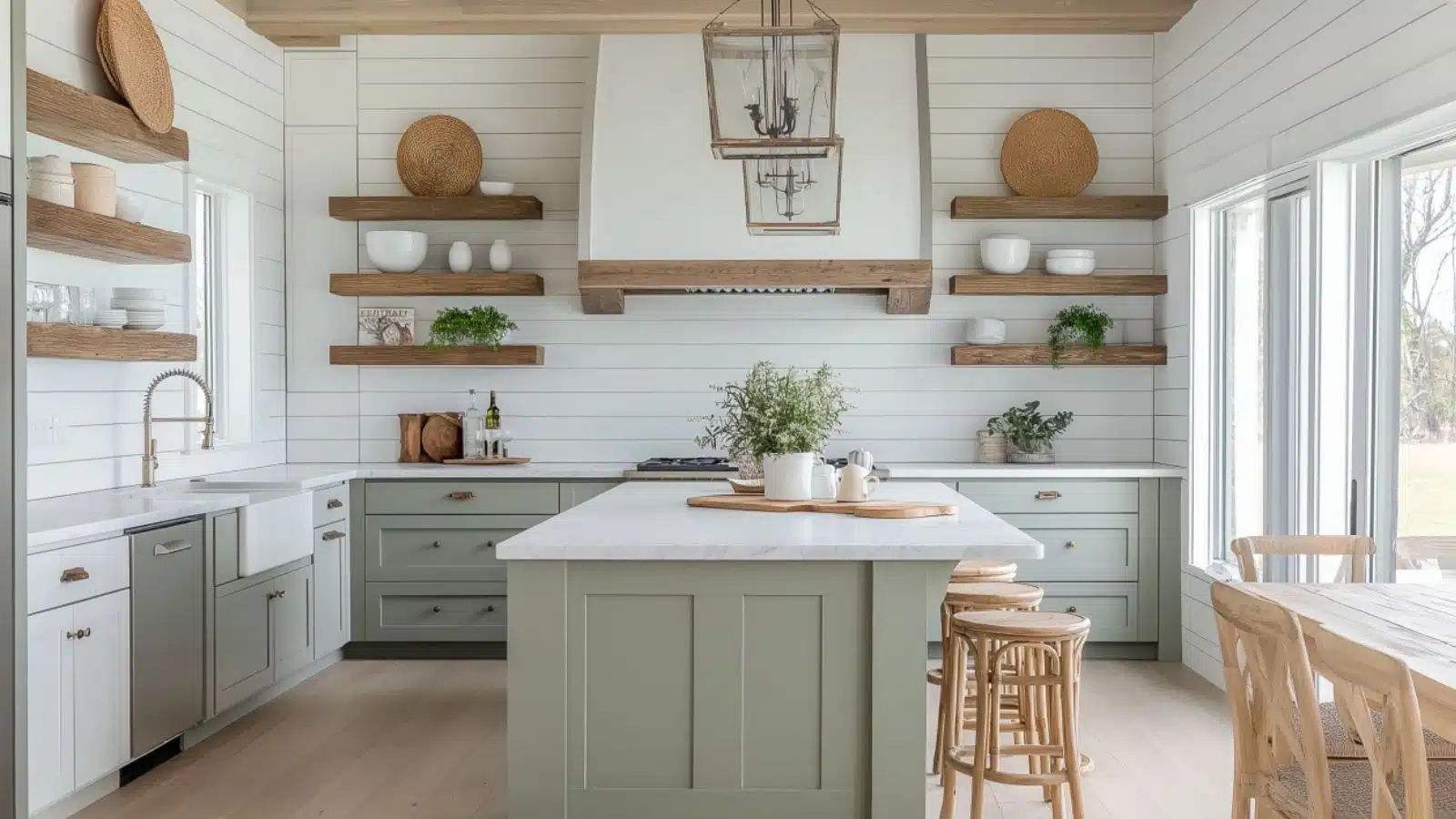Rustic Coastal Kitchen Design Ideas for a Warm, Inviting Space
Table of Contents
There’s something instantly comforting about a rustic coastal kitchen—the kind of space that feels like a warm breeze drifting through a sunlit cottage. Combining the charm of coastal living with the character of rustic design creates a kitchen that is equal parts welcoming, timeless, and casually elegant.
Today’s homeowners are leaning into layered, tactile interiors that offer both beauty and comfort. According to recent home design reports, kitchens inspired by organic coastal palettes and weathered textures are surging in popularity. Why? Because they evoke a sense of ease—a reminder of slower mornings, sea-salted air, and open-concept living with character.
Rustic coastal kitchen design blends shiplap walls and reclaimed wood with breezy whites, sun-washed blues, and soft sandy tones. It’s not about kitschy beach décor—it’s about timeless materials, organic finishes, and a soothing color story. In this post, you’ll discover smart, stylish, and approachable ways to bring rustic coastal character into your kitchen, whether you’re doing a full renovation or just refreshing the vibe.
From natural wood finishes to vintage lighting and sea-inspired hues, let’s explore how to create a space that truly feels like home by the water—even if you’re miles from the coast.
Start with a Neutral Coastal Color Palette
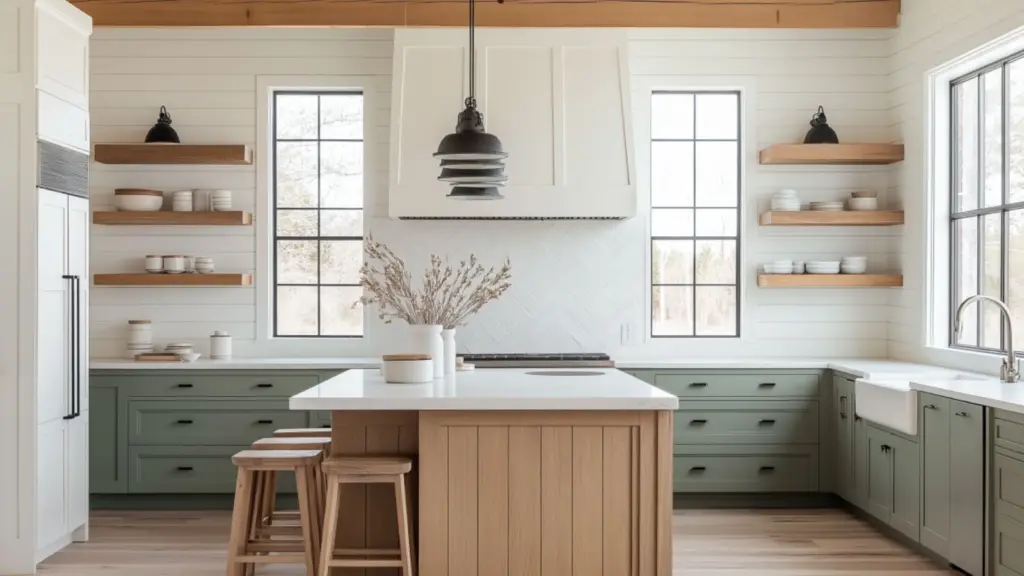
The right color palette is the foundation of a rustic coastal kitchen. To create a warm, inviting space, start with a base of soft, sandy neutrals and sun-bleached whites. These hues mimic driftwood, sea foam, and stonewashed linens—anchoring your design in nature without overpowering it.
Begin with warm white or ivory walls to open up the space and reflect natural light. Then introduce muted tones like sea glass green, foggy gray, or cornflower blue as accents. These colors work beautifully on cabinetry, backsplashes, or even lower base cabinets for a two-tone kitchen look.
Wood finishes should be light and weathered—think white oak, pale walnut, or reclaimed pine. Avoid overly polished or dark stains. Painted finishes with a slightly worn patina add that timeworn, comfortable feeling that rustic coastal kitchens embody.
Table: Rustic Coastal Color Pairings for the Kitchen
| Base Tone | Accent Colors | Suggested Material Use |
|---|---|---|
| Warm white | Foggy gray, pale blue, taupe | Walls, ceilings, trim |
| Sand beige | Soft sage, muted teal, ivory | Cabinetry or backsplash |
| Driftwood brown | Chalk white, dusty blue | Island base, shelving, bar stools |
| Seafoam green | Cream, warm bronze | Lower cabinets or feature walls |
By sticking to this calming palette, your kitchen will feel spacious, timeless, and connected to the outdoors.
Incorporate Reclaimed Wood for Rustic Character
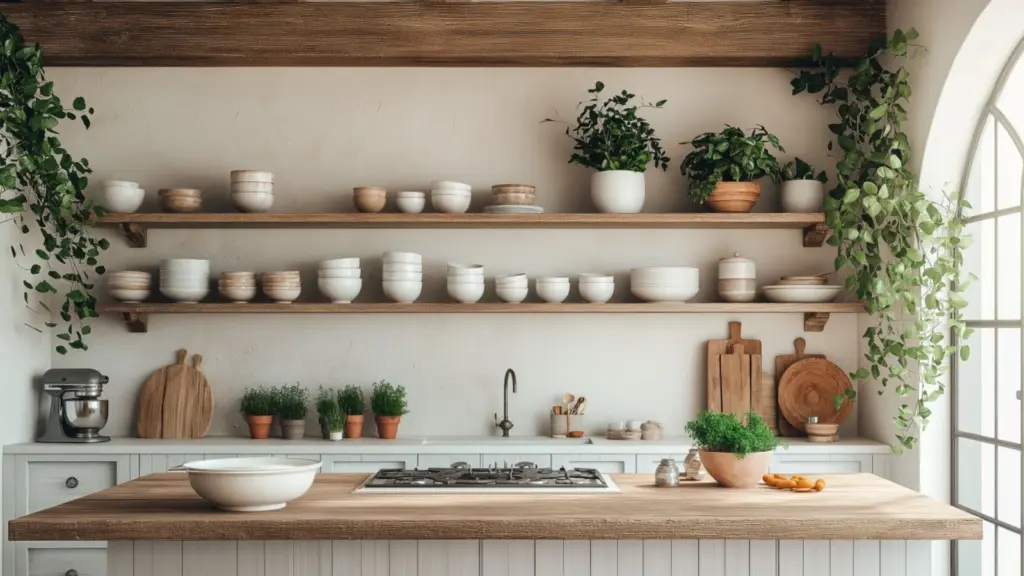
Reclaimed wood is a hallmark of rustic design—and it fits beautifully into a coastal kitchen when used thoughtfully. Its worn grain, knots, and imperfections bring a grounding, organic feel to a space that might otherwise feel too polished.
There are several ways to introduce reclaimed wood into your kitchen: exposed ceiling beams, open shelving, range hood enclosures, or even a butcher block island countertop. The key is balance. Pair raw wood elements with crisp white cabinets or soft tile textures so the space feels both grounded and airy.
You don’t need a full farmhouse remodel to get the look. Even a small wood accent—like a single open shelf displaying ceramic dishes or a reclaimed wood trim on a kitchen hood—can elevate the room with rustic warmth.
Table: Ways to Use Reclaimed Wood in a Coastal Kitchen
| Application Area | Material Style | Design Tip |
|---|---|---|
| Ceiling beams | Reclaimed pine or white oak | Leave raw or whitewashed for contrast |
| Island top | Butcher block with worn finish | Pair with white cabinetry |
| Floating shelves | Sanded reclaimed barn wood | Display minimal ceramic or greenery |
| Range hood trim | Weathered trim detail | Use to break up tile or painted walls |
Reclaimed wood ensures your space doesn’t just look coastal—but also feels storied and full of soul.
Add Natural Texture with Woven and Organic Materials
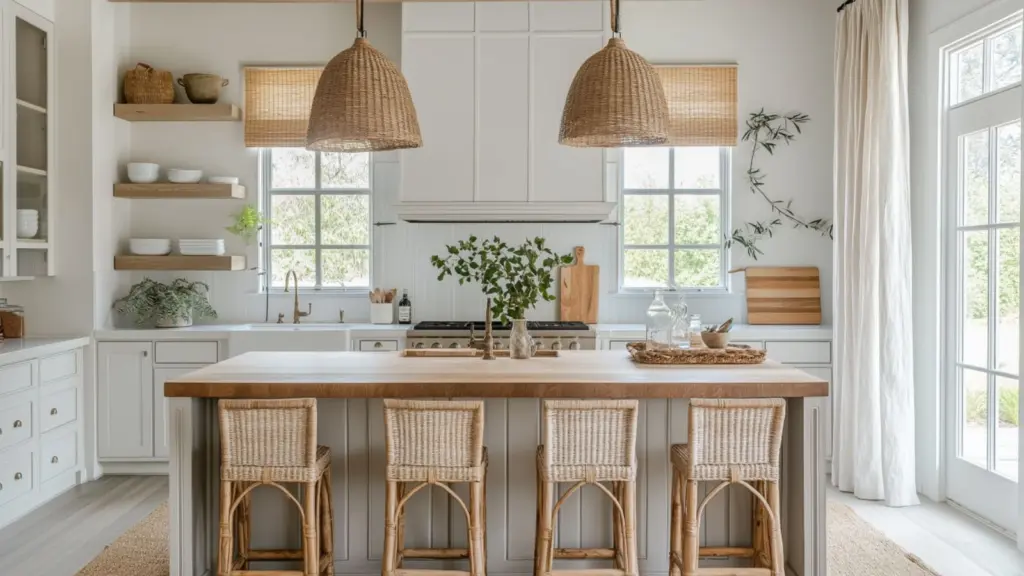
Natural textures play a big role in warming up a coastal kitchen, especially when you’re working with a neutral palette. Elements like rattan, wicker, jute, and cane bring soft texture and tactile depth that elevate the entire space.
Incorporate these materials through light fixtures, bar stools, cabinet fronts, and countertop accessories. A pair of woven pendant lights over the island or cane-front cabinet doors instantly gives the space breezy personality.
Even smaller details matter—like a woven tray holding oils and salt cellars, a jute rug by the sink, or a linen café curtain on a window. These subtle layers make the kitchen feel cozy and lived-in, not staged.
Table: Organic Texture Elements for a Coastal Kitchen
| Material | Suggested Use | Visual Effect |
|---|---|---|
| Rattan or wicker | Pendant lights, bar stools | Adds warmth and lightness |
| Cane | Cabinet fronts, decor trays | Light texture with vintage flair |
| Linen | Curtains, napkins, seat cushions | Softens harder surfaces |
| Jute or seagrass | Rugs, placemats | Rustic charm underfoot |
Natural textures help bridge the rustic and coastal worlds—bringing warmth, breathability, and visual interest into your kitchen design.
Use Coastal-Inspired Lighting with a Vintage Twist
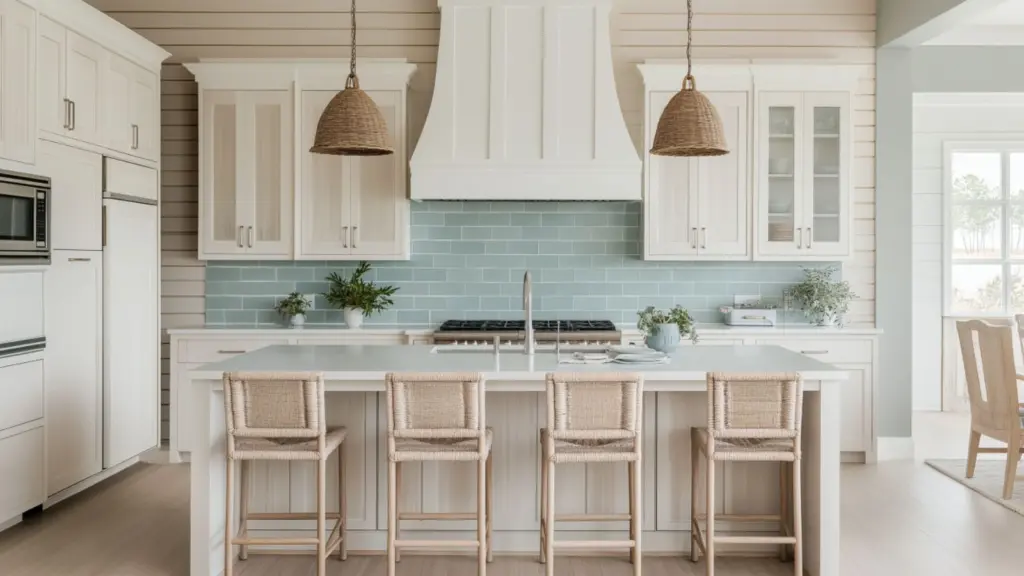
Lighting in a rustic coastal kitchen should be both functional and character-rich. Think vintage-inspired pendants, lantern-style fixtures, or ceramic sconces that look handcrafted. The goal is to bring soft, ambient light into the space without overpowering the natural textures.
Materials like aged brass, matte black iron, or distressed white metal work well in both rustic and coastal schemes. Glass shades or openwork fixtures can prevent the space from feeling too heavy.
When it comes to placement, consider layering lighting: pendants over the island, sconces near open shelves, and a central chandelier or flush-mount in the main prep space. Dimmable options create a cozy ambiance during early mornings or relaxed evenings.
Table: Coastal Lighting Fixtures with Rustic Appeal
| Fixture Type | Material Options | Placement Ideas |
|---|---|---|
| Woven pendant lights | Rattan, seagrass | Above island or dining table |
| Metal lanterns | Black iron, aged bronze | Overhead centerpiece |
| Ceramic sconces | Matte white, hand-painted designs | Beside open shelving or windows |
| Glass dome pendants | Clear or seeded glass with bronze | Kitchen island or work zone |
Good lighting doesn’t just illuminate—it helps tell the story of your space.
Opt for Shiplap, Beadboard, or Soft Tile Backdrops
Wall finishes are a defining detail in rustic coastal kitchens. Shiplap and beadboard add depth and texture while staying true to both farmhouse and coastal aesthetics. These wall treatments work beautifully as a backsplash, island paneling, or even a full feature wall.
If you prefer tile, choose something artisanal and soft—like handmade Zellige, crackle glaze subway tiles, or a weathered mosaic. Look for tones that mimic sand, sea, and stone.
Whether you go for wood paneling or tile, the finish should feel imperfect in a charming way—wavy surfaces, uneven tones, or matte finishes bring life and softness to the kitchen.
Table: Wall Finish Options for Rustic Coastal Style
| Material | Use Case | Aesthetic Benefit |
|---|---|---|
| Shiplap | Full wall, backsplash, island front | Classic farmhouse texture |
| Beadboard | Half wall, cabinetry insets | Adds traditional depth |
| Handmade tile | Backsplash or behind stove | Organic finish and soft reflection |
| Whitewashed brick | Accent wall or oven surround | Rustic contrast with smooth cabinetry |
These materials allow your kitchen walls to become a subtle statement—rich in texture but quiet in tone.
Include Open Shelving with Coastal and Rustic Displays
Open shelving brings a casual, curated look to rustic coastal kitchens. It invites light and air into the space, especially when replacing upper cabinets. These shelves can display everyday items—like stacked dishes, clear jars, or ceramic pitchers—as well as styling pieces like driftwood, vintage books, or seashells.
Wooden shelves supported by iron or brass brackets create a balanced blend of rustic and refined. Keep shelf styling minimal and functional—stick to neutral tones, matte finishes, and natural materials.
The beauty of open shelving is that it evolves with the seasons. You can easily refresh it with sprigs of greenery, coastal art prints, or seasonal kitchen textiles.
Table: Styling Elements for Coastal Kitchen Shelves
| Item Type | Styling Tip | Seasonal Ideas |
|---|---|---|
| Ceramic dishware | Stack in similar tones for cohesion | Swap colors seasonally |
| Glass storage jars | Use for pantry items like pasta or grains | Add wooden lids for rustic flair |
| Natural elements | Driftwood, coral, or woven accents | Rotate with greenery or citrus fruits |
| Framed mini prints | Add visual interest and height variation | Choose soft coastal imagery |
Open shelving tells your kitchen’s story—one texture, tone, and tray at a time.
Conclusion
Creating a rustic coastal kitchen is about finding harmony between laid-back beach vibes and lived-in charm. By combining natural textures, weathered wood, soft lighting, and sea-inspired colors, you’ll craft a space that feels warm, welcoming, and timeless.
Whether you’re building from the ground up or adding subtle touches to your existing kitchen, these rustic coastal design ideas offer practical elegance. They invite the calm of the shoreline and the comfort of the countryside into your everyday cooking and gathering space—proving that beauty lives in simplicity, and warmth comes from thoughtful detail.Tools

